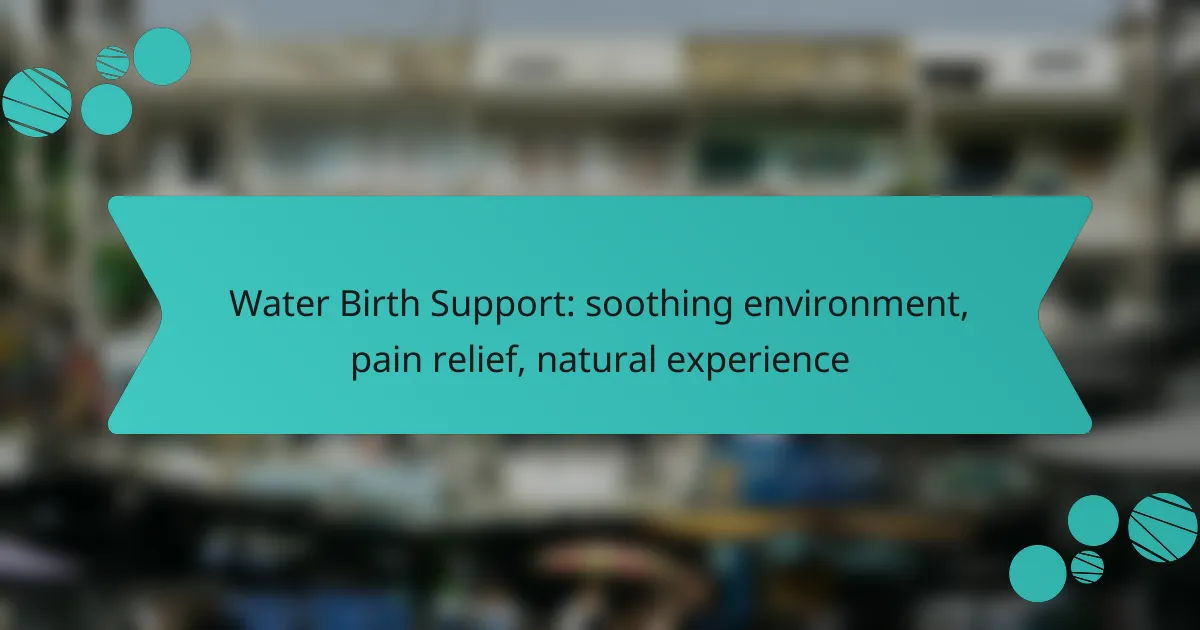Water birth provides a unique and soothing environment that can significantly enhance the birthing experience by offering pain relief and promoting relaxation. The warm water and buoyancy help alleviate discomfort during labor, allowing for a more natural progression. When considering a water birth, it’s essential to choose a location with certified midwives and access to clean water to ensure safety and support throughout the process.
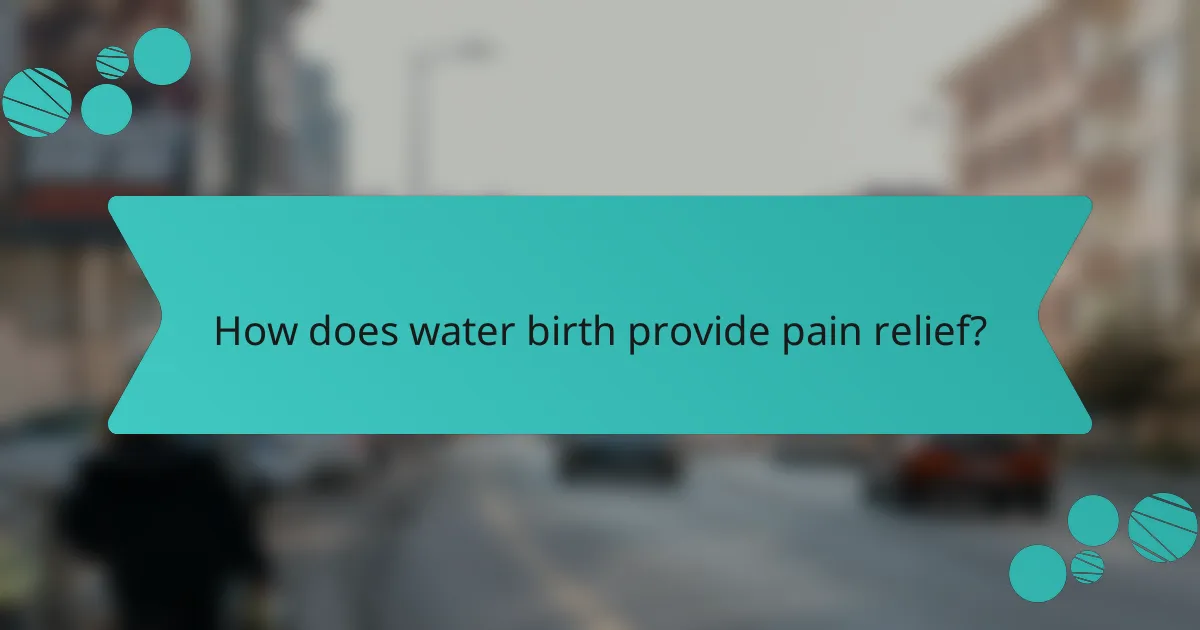
How does water birth provide pain relief?
Water birth offers pain relief by creating a soothing environment that reduces discomfort during labor. The combination of warm water and buoyancy can significantly alleviate the intensity of contractions, making the birthing experience more manageable.
Reduced pressure on the body
Immersion in water during labor helps to reduce pressure on the body, particularly on the pelvis and lower back. This decrease in pressure can lead to a reduction in pain perception, allowing for a more comfortable experience. Many women report feeling lighter and more mobile when submerged, which can facilitate easier movement and positioning during labor.
Warm water soothing effects
The warm water used in water birth has soothing effects that can help relax the muscles and calm the mind. This warmth can mimic the sensations of a warm bath, promoting a sense of comfort and safety. Additionally, the heat can improve blood circulation, which may further aid in pain relief during contractions.
Enhanced relaxation through buoyancy
Buoyancy in water allows for enhanced relaxation, as it supports the body and reduces the strain on muscles and joints. This feeling of weightlessness can help women to let go of tension and anxiety, which are often barriers to effective pain management. The ability to float and move freely can also encourage more natural labor positions, contributing to a more positive birthing experience.

What are the benefits of a soothing environment during water birth?
A soothing environment during water birth promotes relaxation and comfort for the mother, which can significantly enhance the overall birthing experience. This calming atmosphere can lead to reduced pain perception and a more natural progression of labor.
Calm atmosphere for mother
A calm atmosphere is essential for the mother during water birth as it helps her feel safe and supported. Soft lighting, gentle music, and a warm water temperature can create a serene space that encourages relaxation.
Consider incorporating elements such as aromatherapy or personal items that evoke positive memories. These can enhance the soothing environment, making the mother feel more at ease during labor.
Lower stress levels for baby
A soothing environment not only benefits the mother but also contributes to lower stress levels for the baby. When the mother is relaxed, her body produces fewer stress hormones, which can positively affect the baby’s heart rate and overall well-being.
Maintaining a peaceful atmosphere can help the baby transition more smoothly into the world. This is particularly important as high-stress levels during birth can lead to complications for the newborn.
Improved labor progression
Creating a soothing environment can lead to improved labor progression. When the mother is comfortable and relaxed, her body is more likely to produce oxytocin, a hormone that stimulates contractions and helps labor advance.
It is beneficial to allow the mother to move freely in the water, as this can help her find positions that are most comfortable and effective for labor. Keeping the environment quiet and minimizing interruptions can further support this natural process.
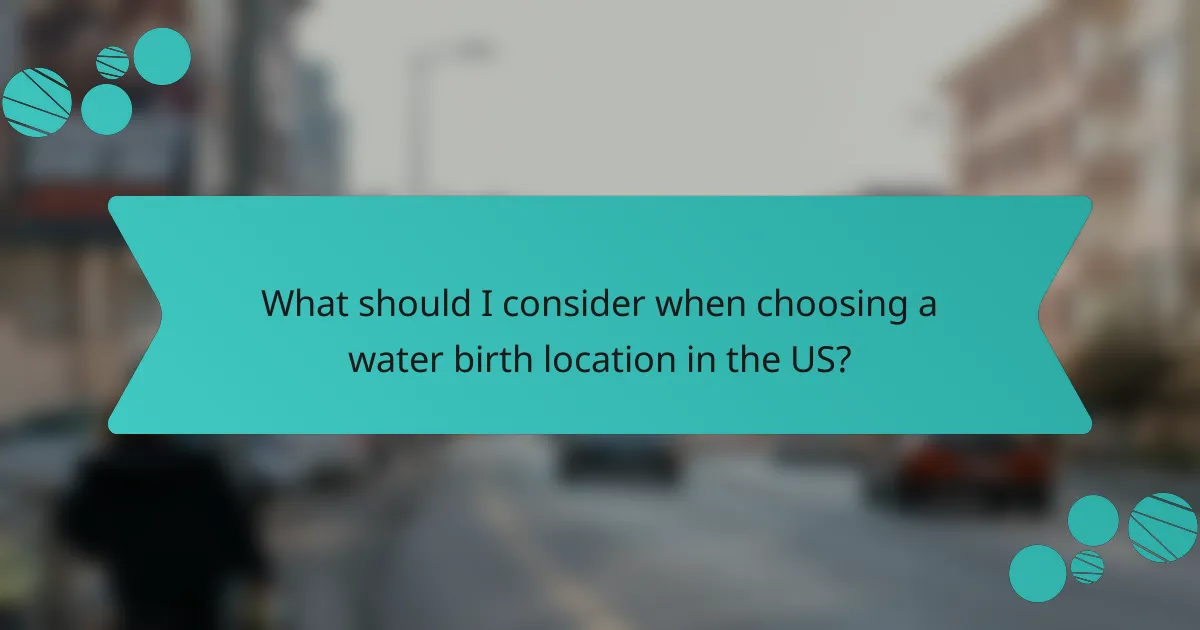
What should I consider when choosing a water birth location in the US?
When selecting a water birth location in the US, prioritize certified midwives, access to clean water, and nearby medical facilities. These factors ensure a safe and supportive environment for the birthing process.
Availability of certified midwives
Choosing a location with certified midwives is crucial for a safe water birth. Certified midwives are trained to handle various birthing scenarios and can provide essential support during labor. Ensure the midwives have experience with water births specifically, as this can enhance your comfort and safety.
Research local midwifery practices and ask for recommendations from other parents. Verify their credentials and inquire about their experience with water births to ensure you receive quality care.
Access to clean, safe water
Access to clean and safe water is essential for a successful water birth. The water should be heated to a comfortable temperature, typically between 95°F and 100°F (35°C to 37.8°C), to help with relaxation and pain relief. Confirm that the facility has systems in place to maintain water quality throughout the birthing process.
Consider asking about the water source and any filtration systems in use. Facilities should adhere to health regulations to ensure the water is free from contaminants, providing peace of mind during labor.
Proximity to medical facilities
Proximity to medical facilities is another important consideration when choosing a water birth location. In case of complications, having a hospital nearby can be crucial for a quick transfer. Ideally, the facility should be within a short drive of a hospital equipped to handle emergencies.
Evaluate the distance and travel time to the nearest medical center. Familiarize yourself with the route and any potential traffic issues to ensure a smooth transition if needed during labor.
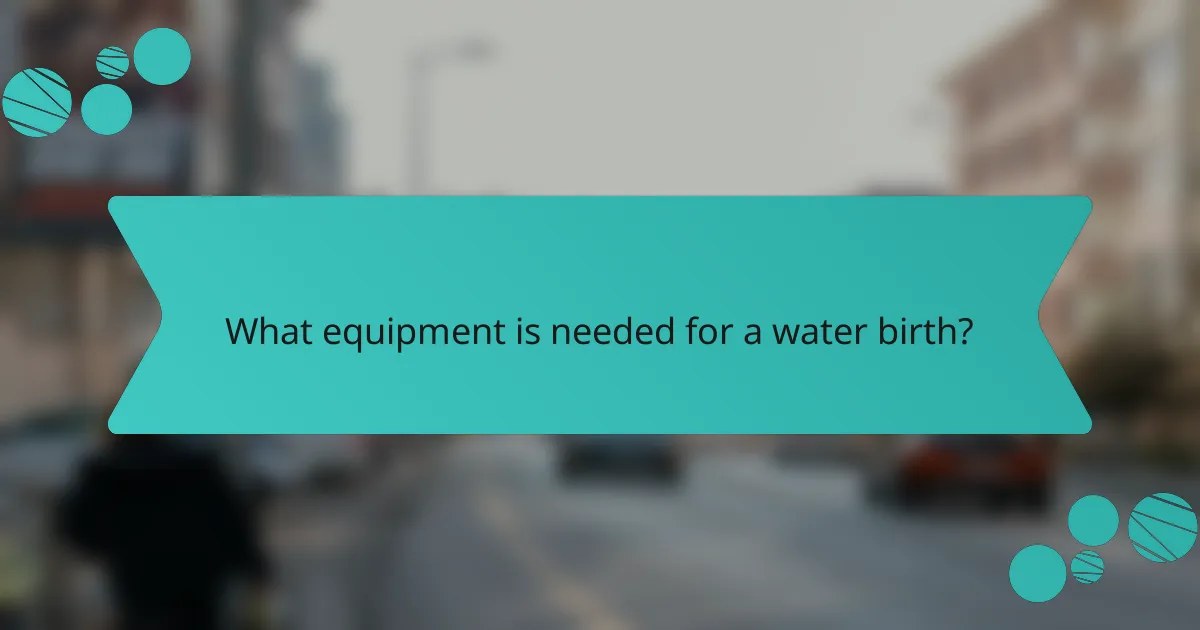
What equipment is needed for a water birth?
For a successful water birth, essential equipment includes an inflatable birthing pool, a water thermometer, and hydration supplies. These items help create a soothing environment, ensure safety, and support the birthing process.
Inflatable birthing pool
An inflatable birthing pool is designed specifically for water births, providing a comfortable space for labor and delivery. When selecting a pool, consider its size, depth, and material to ensure it can accommodate your needs and those of your baby.
Many birthing pools are easy to set up and can be filled with warm water to help ease pain during labor. Ensure that the pool is made from non-toxic materials and meets safety standards to provide a safe environment for both mother and child.
Water thermometer
A water thermometer is crucial for monitoring the temperature of the water in the birthing pool. The ideal water temperature for labor is typically between 36°C and 37.5°C (97°F to 99.5°F), which helps maintain comfort and relaxation.
Regularly check the water temperature to avoid overheating or cooling, as this can affect the mother’s comfort and the baby’s well-being. A simple digital thermometer can provide accurate readings quickly and easily.
Hydration supplies
Staying hydrated during labor is essential, so having hydration supplies on hand is important. This can include water bottles, electrolyte drinks, or herbal teas that are safe for consumption during pregnancy.
Consider preparing a small cooler with your preferred beverages to keep them easily accessible. Staying hydrated can help maintain energy levels and support overall comfort during the birthing process.
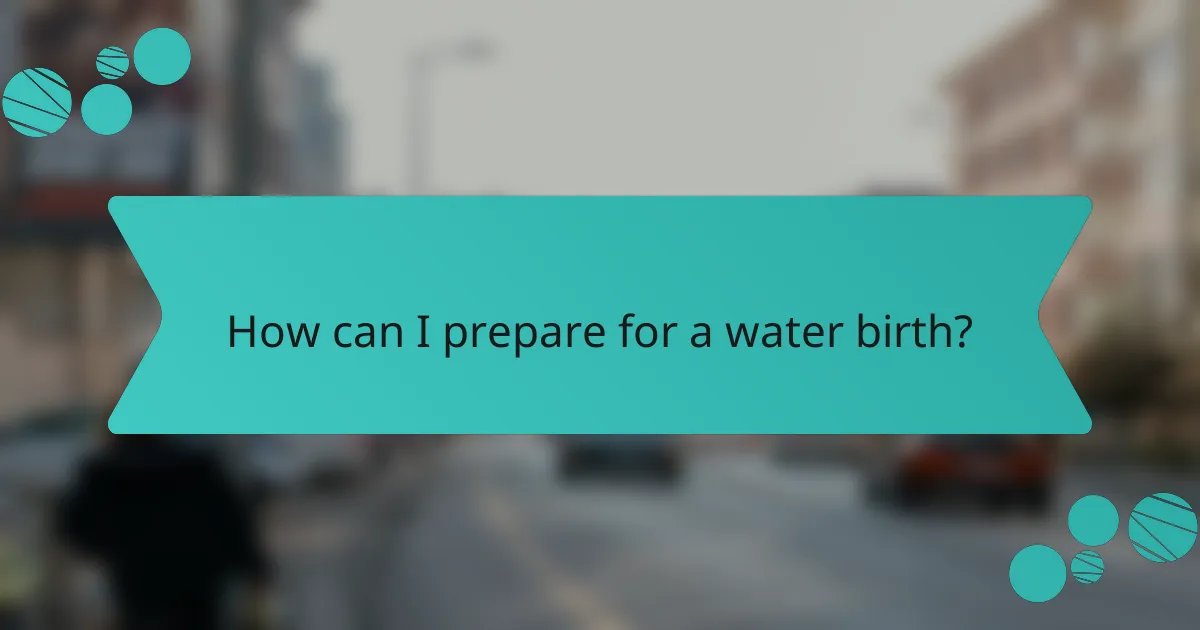
How can I prepare for a water birth?
Preparing for a water birth involves several key steps to ensure a safe and comfortable experience. This includes discussing your plans with a healthcare provider, gathering the necessary supplies, and practicing relaxation techniques.
Discuss with healthcare provider
Engaging in a thorough discussion with your healthcare provider is crucial for a successful water birth. They can help assess your health and the suitability of water birth based on your pregnancy and any potential complications.
Ask about the facility’s policies on water births, including any specific requirements or regulations that may apply. Understanding the options available to you will help you make informed decisions.
Gather necessary supplies
Collecting the right supplies is essential for a smooth water birth experience. You will need a birthing pool or tub, a waterproof cover, and a heater to maintain the water temperature. Additionally, consider having towels, a water thermometer, and a hose for filling the tub.
Check with your healthcare provider about any additional items they recommend, such as a birth ball or aromatherapy oils, to enhance your comfort during labor.
Practice relaxation techniques
Practicing relaxation techniques can significantly improve your water birth experience. Techniques such as deep breathing, visualization, and gentle movement can help manage pain and anxiety during labor.
Consider attending prenatal classes that focus on relaxation and water birth preparation. These classes often provide valuable insights and practical exercises to help you feel more confident and calm on the day of your birth.
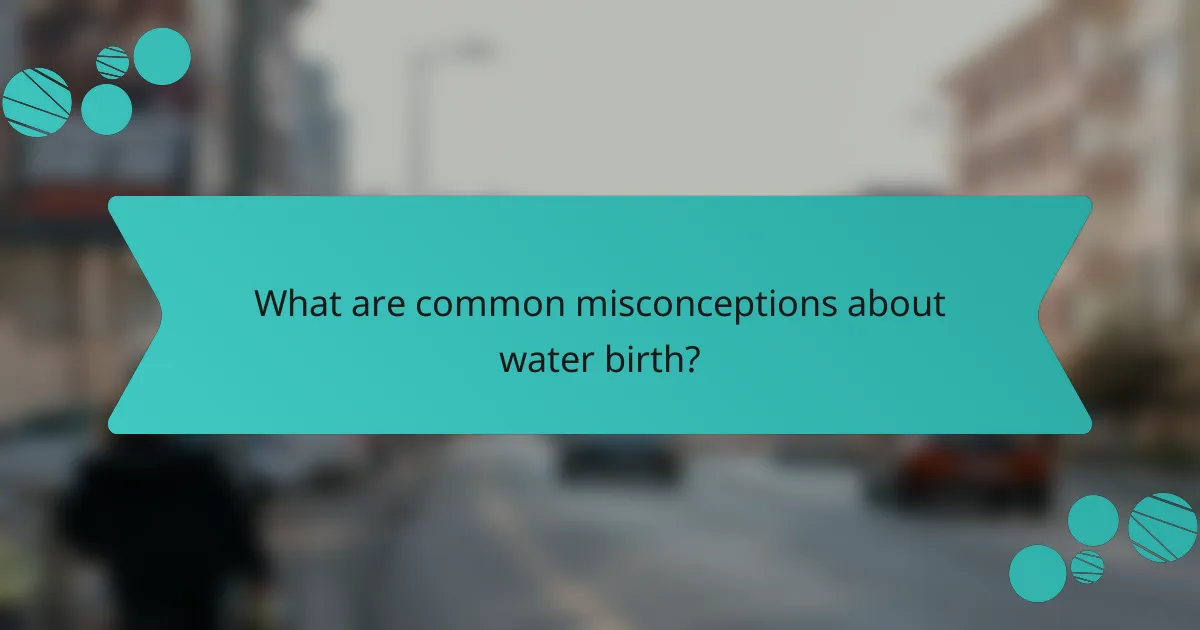
What are common misconceptions about water birth?
Many misconceptions surround water birth, often leading to confusion about its safety and suitability. Understanding these myths can help expectant parents make informed decisions regarding their birthing options.
Water birth is unsafe
A common belief is that water birth poses significant risks to both the mother and baby. However, when conducted in a controlled environment by trained professionals, water birth can be a safe option. Studies suggest that water immersion during labor can reduce stress and pain, leading to a more positive experience.
It’s essential to ensure that the birthing facility adheres to established safety protocols, including regular monitoring of the mother and baby. Choosing a certified midwife or obstetrician experienced in water births can further enhance safety.
Water birth is only for home settings
Another misconception is that water birth is exclusively for home settings. In reality, many hospitals and birthing centers offer water birth facilities equipped with birthing tubs. These locations often provide a balance of comfort and medical support, allowing for a natural experience while ensuring access to emergency care if needed.
Expectant parents should explore local options, as some hospitals may have specific water birth programs. Checking with healthcare providers about available facilities can help in making the best choice for a water birth experience.
